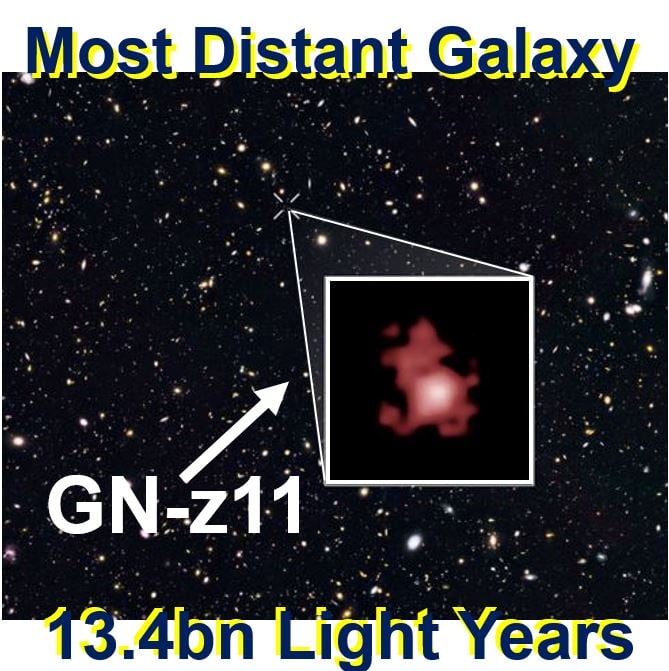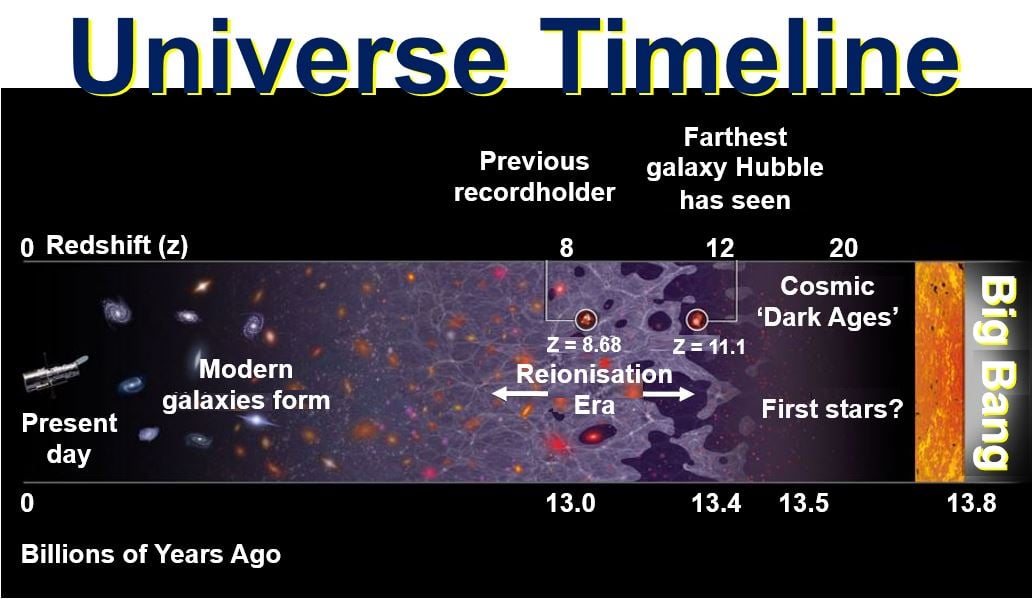The most distant galaxy ever has been detected by the Hubble Space Telescope – it is 13.4 billion light years away, which means what we see now is how it was just 400 million years after the Big Bang, when our Universe was born.
A team of scientists wrote in the Astrophysical Journal (soon to be published) that the remarkable discovery provides new insights into the first generation of galaxies that emerged in the Universe.
It is the first time that the distance of an object so far away has been measured from its spectrum, which makes the measurements very reliable.
 Our Universe was just 400 million years old when this galaxy emerged. (Image: cdn.spacetelescope.org)
Our Universe was just 400 million years old when this galaxy emerged. (Image: cdn.spacetelescope.org)
Distant galaxy called GN-z11
An international team of astronomers and astrophysicists used the NASA/ESA Hubble Space Telescope to measure the distance of this new galaxy – GN-z11.
Although very faint, the galaxy is extremely bright considering how far away it is from us. GNz11’s distance provides further strong evidence that other very bright galaxies that the Hubble Telescope had found earlier are really ultra-distant from us. This shows that scientists are closing in on the first galaxies that formed in the early Universe.
Astronomers had previously estimated GN-z11’s distance by analysing its colour in images taken with the Spitzer Space Telescope and Hubble. This time, the team used Hubble’s Wide Field Camera 3 (WFC3) to accurately measure the distance to this galaxy spectroscopically, by splitting the light into its component colours.
Second author, Gabriel Brammer, who works at Johns Hopkins University’s Space Telescope Science Institute, said:
“Our spectroscopic observations reveal the galaxy to be even further away than we had originally thought, right at the distance limit of what Hubble can observe.”
 An illustration showing the timeline of the Universe, stretching from the present day (left) back to the Big Bang, 13.8 billion years ago. GN-z11 is the most distant galaxy discovered so far. The previous record holder’s position is also identified. GN-z11’s remote position puts it at the beginning of the reionisation era. In this period starlight from the first galaxies started to heat and lift the fog of cold hydrogen gas filling the Universe. (Image: cdn.spacetelescope.org)
An illustration showing the timeline of the Universe, stretching from the present day (left) back to the Big Bang, 13.8 billion years ago. GN-z11 is the most distant galaxy discovered so far. The previous record holder’s position is also identified. GN-z11’s remote position puts it at the beginning of the reionisation era. In this period starlight from the first galaxies started to heat and lift the fog of cold hydrogen gas filling the Universe. (Image: cdn.spacetelescope.org)
Before using this method, researchers had thought that such distant galaxies could only be reached using the upcoming NASA/ESA/CSA James Webb Space Telescope (JWST).
A mega look back in time
Lead author, Pascal Oesch, a YCAA Fellow at Yale University, said:
“We’ve taken a major step back in time, beyond what we’d ever expected to be able to do with Hubble.”
“We managed to look back in time to measure the distance to a galaxy when the Universe was only three percent of its current age.”
To determine the distance of faraway objects, like the one to this galaxy, astronomers measure the redshift of the observed object. Redshift is the result of the expansion of the Universe – every distant object out there appears to be moving away from us, and as a result their light is stretched to longer, redder wavelengths.
 Data from the Hubble and Spitzer space telescopes were used to calculate the distance of the remote galaxy. (Images: Wikipedia)
Data from the Hubble and Spitzer space telescopes were used to calculate the distance of the remote galaxy. (Images: Wikipedia)
This Caltech explanation of redshift is useful for lay people who want to gain a general idea of what it is:
“To understand what a redshift is, think of how the sound of a siren changes as it moves toward and then away from you. As the sound waves from the siren move toward you, they are compressed into higher frequency sound waves.”
“As the siren moves away from you, its sound waves are stretched into lower frequencies. This shifting of frequencies is called the Doppler effect. A similar thing happens to light waves.”
GN-z11’s redshift 11.1
Before the distance of GN-z11 was determined, the most distant galaxy we had measured – EGSY8p7 – had a redshift of 8.68. Scientists have now confirmed that GN-z11’s redshift is 11.1, which corresponds to 400 million years after our Universe was born (the Big Bang).
Co-author Rychard Bouwens, Associate Professor at Leiden Observatories, Leiden University, the Netherlands, said:
“The previous record-holder was seen in the middle of the epoch when starlight from primordial galaxies was beginning to heat and lift a fog of cold, hydrogen gas. This transitional period is known as the reionisation era.”
“GN-z11 is observed 150 million years earlier, near the very beginning of this transition in the evolution of the Universe.”
Data taken from the Spitzer and Hubble telescopes revealed that the newborn galaxy is twenty-five times smaller than the Milky Way, and has only 1% of our galaxy’s mass in stars.
GN-z11 -roducing lots of new stars
However, the infant GN-z11 is a prolific star factory – its star population is growing rapidly, about 20 times faster than the Milky Way’s rate. That is why it is bright enough for Hubble to see and perform detailed observations.
However, the existence of such a bright and large galaxy in not predicted in theory – the discovery raises as many questions as it answers.
Professor/Astronomer Garth Illingworth, who works at the Physical & Biological Sciences Department, University of California, Santa Cruz, said:
“It’s amazing that a galaxy so massive existed only 200 million to 300 million years after the very first stars started to form. It takes really fast growth, producing stars at a huge rate, to have formed a galaxy that is a billion solar masses so soon.”
Prof.dr. M. (Marijn) Franx, from the Leiden Observatory, said regarding the discovery:
“The discovery of GN-z11 was a great surprise to us, as our earlier work had suggested that such bright galaxies should not exist so early in the Universe.”
Dr. Ivo Labbe, also from the Leiden Observatory, added:
“The discovery of GN-z11 showed us that our knowledge about the early Universe is still very restricted. How GN-z11 was created remains somewhat of a mystery for now. Probably we are seeing the first generations of stars forming around black holes?”
The research team says their latest findings provide a tantalising glimpse of the kind of observations that the James Webb Space Telescope will perform.
Prof. Illingworth concluded:
“This new discovery shows that JWST will surely find many such young galaxies reaching back to when the first galaxies were forming.”
Citation: ‘A REMARKABLY LUMINOUS GALAXY AT Z = 11.1 MEASURED WITH HUBBLE SPACE TELESCOPE GRISM SPECTROSCOPY,’ P. A. Oesch, G. Brammer, P. G. van Dokkum, G. D. Illingworth, R. J. Bouwens, I. Labbe, M. Franx, I. Momcheva, M. L. N. Ashby, G. G. Fazio, V. Gonzalez, B. Holden, D. Magee, R. E. Skelton, R. Smit, L. R. Spitler, M. Trenti, S. P. Willner. Draft version March 3, 2016. arXiv:1603.00461v1 [astro-ph.GA] 1 Mar 2016. To be published in Astrophysical Journal.
Video – Zoom on GN-z11
This Hubble ESA video shows a zoom on the galaxy GNz11.
